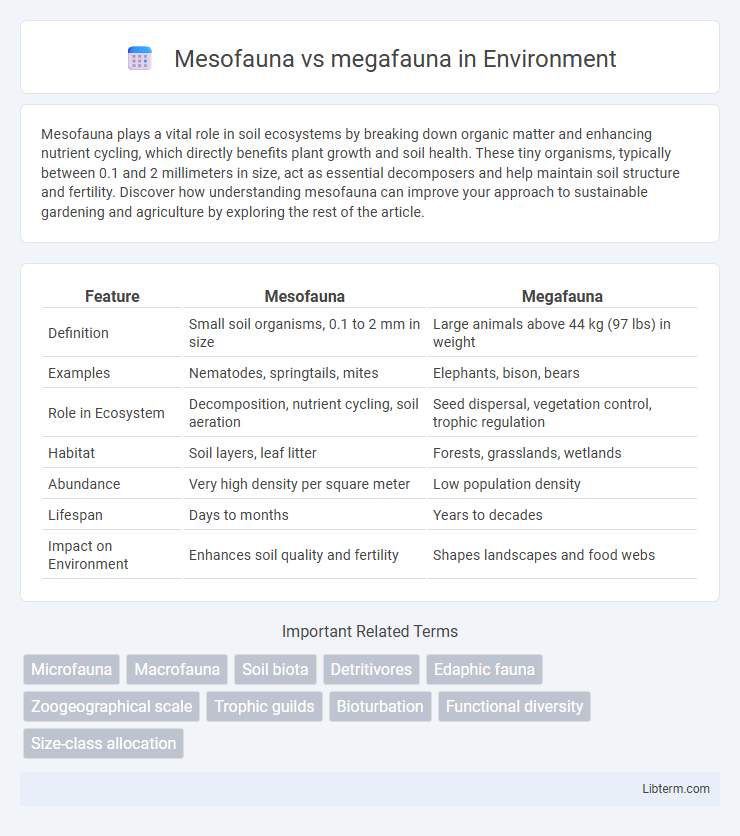Mesofauna plays a vital role in soil ecosystems by breaking down organic matter and enhancing nutrient cycling, which directly benefits plant growth and soil health. These tiny organisms, typically between 0.1 and 2 millimeters in size, act as essential decomposers and help maintain soil structure and fertility. Discover how understanding mesofauna can improve your approach to sustainable gardening and agriculture by exploring the rest of the article.
Table of Comparison
| Feature | Mesofauna | Megafauna |
|---|---|---|
| Definition | Small soil organisms, 0.1 to 2 mm in size | Large animals above 44 kg (97 lbs) in weight |
| Examples | Nematodes, springtails, mites | Elephants, bison, bears |
| Role in Ecosystem | Decomposition, nutrient cycling, soil aeration | Seed dispersal, vegetation control, trophic regulation |
| Habitat | Soil layers, leaf litter | Forests, grasslands, wetlands |
| Abundance | Very high density per square meter | Low population density |
| Lifespan | Days to months | Years to decades |
| Impact on Environment | Enhances soil quality and fertility | Shapes landscapes and food webs |
Introduction to Mesofauna and Megafauna
Mesofauna refers to small soil organisms typically ranging from 0.1 to 2 millimeters, including mites, springtails, and nematodes, crucial for nutrient cycling and soil structure. Megafauna encompasses large animals often exceeding 44 kilograms, such as elephants, bears, and whales, playing significant roles in ecosystem engineering and trophic dynamics. Understanding the size-based classification between mesofauna and megafauna highlights the diverse ecological functions and interactions these groups maintain within terrestrial and aquatic environments.
Defining Mesofauna: Size and Characteristics
Mesofauna are microscopic soil organisms typically ranging from 0.1 to 2 millimeters in size, including nematodes, microarthropods, and tardigrades. These creatures play crucial roles in nutrient cycling, soil structure maintenance, and organic matter decomposition. Unlike megafauna, which are larger animals exceeding 44 kilograms and visible to the naked eye, mesofauna operate at a micro scale, significantly influencing soil ecosystems and biodiversity.
Understanding Megafauna: Features and Examples
Megafauna refers to large animals, typically weighing over 44 kilograms (about 97 pounds), such as elephants, whales, and giant ground sloths, known for their significant ecological impact and distinct morphological features like massive body size and specialized adaptations. These animals play crucial roles in their ecosystems by influencing vegetation patterns, nutrient cycling, and habitat structure. Understanding megafauna helps in studying past ecosystems, such as the Pleistocene epoch, where species like mammoths and saber-toothed cats dominated, highlighting the contrast with smaller mesofauna that occupy different ecological niches.
Habitat Differences: Where Mesofauna and Megafauna Thrive
Mesofauna predominantly inhabit soil, leaf litter, and decaying organic matter, thriving in microhabitats with high moisture and stable temperatures. Megafauna occupy larger, more open environments such as forests, grasslands, and savannas, requiring extensive territories to support their substantial food and shelter needs. These habitat differences reflect the distinct ecological roles and physiological demands between small-scale mesofauna and large-scale megafauna species.
Ecological Roles of Mesofauna
Mesofauna, such as springtails and mites, play crucial ecological roles by decomposing organic matter and enhancing soil nutrient cycling, which supports plant growth and ecosystem productivity. These small organisms regulate microbial populations and improve soil structure through their burrowing activities, promoting aeration and water infiltration. In contrast, megafauna, like large herbivores and predators, influence ecosystems primarily through trophic interactions and habitat modification, whereas mesofauna maintain essential soil processes at the microhabitat level.
Megafauna’s Impact on Ecosystems
Megafauna significantly shape ecosystems by influencing vegetation patterns, nutrient cycling, and habitat structures through their feeding and movement activities. Their large size and biomass enable them to act as ecosystem engineers, creating habitats for smaller species and promoting biodiversity. The decline or extinction of megafauna often leads to trophic cascades, reduced seed dispersal, and altered ecosystem dynamics that can diminish overall ecological resilience.
Evolutionary Adaptations: Mesofauna vs Megafauna
Mesofauna exhibit evolutionary adaptations such as enhanced surface-area-to-volume ratios that facilitate efficient moisture retention and nutrient absorption in microhabitats, whereas megafauna have evolved robust musculoskeletal systems and advanced metabolic rates to support larger body masses and greater mobility. Genetic diversification in mesofauna often involves rapid reproduction cycles for quick environmental adaptation, contrasting with the slower generational turnover and complex social behaviors seen in megafauna. These divergent evolutionary strategies underscore the ecological niches occupied by mesofauna and megafauna, reflecting their distinct survival mechanisms and environmental interactions.
Threats and Conservation Challenges
Mesofauna face habitat degradation and pesticide exposure that threaten their soil ecosystem functions, while megafauna are primarily imperiled by habitat loss, poaching, and human-wildlife conflict. Conservation challenges for mesofauna include limited research and lack of public awareness, hindering effective soil biodiversity protection. Megafauna conservation requires large protected areas and complex management strategies to mitigate threats and ensure population recovery.
Significance in Biodiversity and Food Webs
Mesofauna, such as mites and springtails, play a critical role in soil biodiversity by decomposing organic matter and facilitating nutrient cycling, which supports plant growth and ecosystem productivity. Megafauna, including large herbivores and predators, shape ecosystems through top-down control, influencing species composition and maintaining healthy food webs. The interaction between mesofauna and megafauna enhances ecosystem resilience by promoting energy flow across multiple trophic levels and stabilizing ecological networks.
Future Perspectives: Studying Faunal Diversity
Future perspectives in studying mesofauna and megafauna emphasize integrating advanced genomic techniques and remote sensing technologies to uncover hidden diversity and ecological roles. Understanding the interactions between these faunal groups aids in predicting ecosystem responses to climate change and habitat alterations. Emphasizing cross-scale analyses enhances conservation strategies by linking microhabitat functions of mesofauna with broader ecosystem impacts of megafauna.
Mesofauna Infographic

 libterm.com
libterm.com